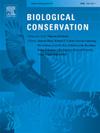Both pond creation and restoration provide long term biodiversity gains in agricultural landscapes: implications for conservation
IF 4.4
1区 环境科学与生态学
Q1 BIODIVERSITY CONSERVATION
引用次数: 0
Abstract
Ponds are globally recognised for their unique contribution to freshwater biodiversity. However, due to agricultural intensification and urban development, many ponds within human-dominated landscapes have been lost, while many remaining ponds in such environments have become heavily terrestrialised, which has significantly reduced landscape-scale freshwater biodiversity. To reverse such trends, two main conservation approaches have been employed: pond creation and pond restoration. However, there remains a limited understanding on the longer-term effectiveness of these conservation techniques. This study aimed to quantify and compare long term responses of aquatic macrophyte communities among 56 created (28) and restored (28) ponds across an agricultural landscape in eastern England (United Kingdom). For both approaches, alpha and gamma richness were significantly higher 11+ years after intervention compared to 1–2 years following intervention, but their temporal trajectories differed. Plant colonisation was faster at restored compared to created ponds, with the former displaying a significantly higher taxonomic richness 1–2 and 3–6 years post-intervention. At 11+ years after pond creation or restoration, similar alpha and gamma diversity was recorded for the two conservation approaches. Successive time periods generally demonstrated more similar macrophyte communities within restored and created ponds, and macrophyte compositional differences between created and restored ponds decreased with time. Pond restoration and creation should be used as complementary approaches to create broader abiotic and biotic gradients, in turn supporting different species and community compositions across the landscape. Both approaches are urgently needed to bend the curve on global freshwater biodiversity losses.
池塘的建立和恢复都为农业景观提供了长期的生物多样性收益:对保护的影响
池塘因其对淡水生物多样性的独特贡献而得到全球认可。然而,由于农业集约化和城市发展,人类主导景观中的许多池塘已经消失,而这种环境中许多剩余的池塘已经严重陆地化,这大大降低了景观尺度的淡水生物多样性。为了扭转这种趋势,采用了两种主要的保护方法:建立池塘和恢复池塘。然而,对这些保护技术的长期有效性的了解仍然有限。本研究旨在量化和比较英国东部农业景观中56个新建和恢复的池塘中水生大型植物群落的长期反应。两种方法的α和γ丰富度在干预后11年以上显著高于干预后1-2年,但其时间轨迹不同。恢复池的植物定植速度比新建池快,干预后1-2年和3-6年,恢复池的植物分类丰富度显著高于新建池。在池塘建立或恢复后11年以上,两种保护方法记录的α和γ多样性相似。在连续的时间周期内,恢复池塘和人工池塘内的大型植物群落基本相似,并且随着时间的推移,人工池塘和人工池塘之间的大型植物组成差异逐渐减小。池塘的恢复和创造应该作为互补的方法来创造更广泛的非生物和生物梯度,反过来支持景观中不同的物种和群落组成。我们迫切需要这两种方法来扭转全球淡水生物多样性丧失的趋势。
本文章由计算机程序翻译,如有差异,请以英文原文为准。
求助全文
约1分钟内获得全文
求助全文
来源期刊

Biological Conservation
环境科学-环境科学
CiteScore
10.20
自引率
3.40%
发文量
295
审稿时长
61 days
期刊介绍:
Biological Conservation is an international leading journal in the discipline of conservation biology. The journal publishes articles spanning a diverse range of fields that contribute to the biological, sociological, and economic dimensions of conservation and natural resource management. The primary aim of Biological Conservation is the publication of high-quality papers that advance the science and practice of conservation, or which demonstrate the application of conservation principles for natural resource management and policy. Therefore it will be of interest to a broad international readership.
 求助内容:
求助内容: 应助结果提醒方式:
应助结果提醒方式:


